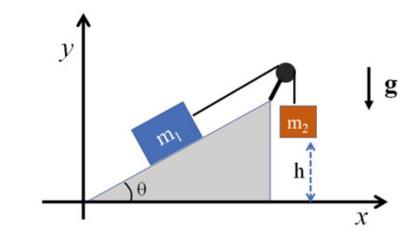A wedge of very large mass and angle (theta=30^{circ}) is resting on a horizontal surface as shown
Question:
A wedge of very large mass and angle \(\theta=30^{\circ}\) is resting on a horizontal surface as shown in Fig.4.15. Two bodies, of mass \(m_{1}=500 \mathrm{~g}\) and \(m_{2}\) are arranged as in the figure and connected to each other by a inextensible rope of negligible mass, running on a pulley also of negligible mass. The mass \(m_{2}\) is initially stationary at height \(h=1.00 \mathrm{~m}\) from the horizontal plane. The static coefficient of friction between the body of mass \(m_{1}\) and the top surface of the wedge is \(\mu_{s}=0.500\), while the dynamic coefficient of friction is \(\mu_{d}=0.400\). The friction between the wedge and the horizontal plane is sufficient to keep the wedge stationary at all times.
1. Determine what are the minimum \(M_{\min }\) and maximum \(M_{\max }\) values that the mass \(m_{2}\) can have if it is observed to remain stationary, as in the Fig. 4.15, at height \(h\). For the value \(m_{2}=1.00 \mathrm{~kg}\), it is observed that it begins to move downward. For such a value of \(m_{2}\) determine:
2. the tension of the rope;
3. with what speed the mass \(m_{2}\) impacts the horizontal plane;
4. the time taken to travel the distance \(h\).
Fig. 4.15

Step by Step Answer:






